- HOME
- ABOUT US
- SOLUTIONS
- Metal Roof PV Mounts and Systems
- Flat Roof Solar Panel Mounting Systems Solutions
- Tile Roof Solar Mounting Systems Solutions
- Solar Tracking Solutions for Commercial PV Projects
- Ground Solar Mounting Systems Solutions
- Floating Solar Solutions - PV Systems
- PV Solar Carport Mounting Systems Solutions
- Balcony Solar Panel Mounting Systems Solutions
- PRODUCTS
- PROJECTS
- COMPANY NEWS
- BLOG
- Contact Us
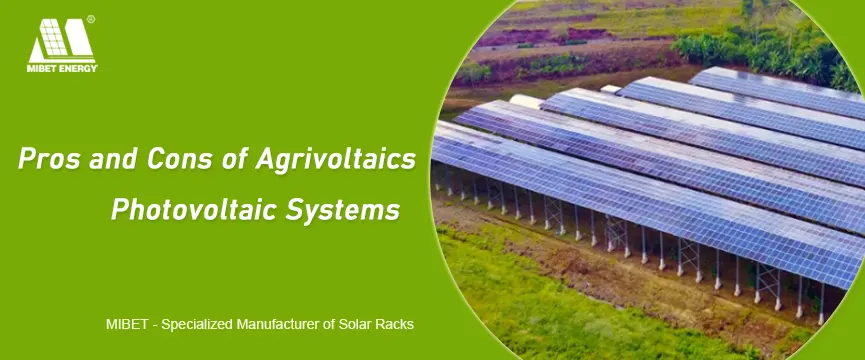
Solar photovoltaics(PV) is currently one of the most popular clean energy sources. A growing number of people, from household energy users to the commercial sector, harvest solar energy because it is profitable and easily accessible. Agri-PV systems combine food and energy production, allowing a piece of land to be used for both agricultural production and solar power generation at the same time.
This type of collaboration is not new in the industry. Wind developers frequently use agricultural terrain to harness the power of the wind, or animals grazing in farms help control the height of the grass in solar PV fields. Continue reading for an in-depth look at what agrivoltaic systems are, how they work, and the pros and cons of such systems.
What is Agrivoltaic Technology?
Agrivoltaics is a technique that combines agricultural and PV power generation on the same piece of land. It was founded in 1981 by Armin Zastrow and Adolf Goetzberger. The coexistence of crops and solar panels on the same plot of land necessitates the sharing of sunlight between the two types of production. Agrivoltaic systems, on the other hand, must meet specific technical and structural requirements in order to be permitted for dual land use.
● Module technologies: In agriculture, module technologies that allow the light spectrum required for plant growth to pass are especially important. For instance, the technology of organic PV modules and semi-transparent modules.
● Light control: Balancing electricity production and agricultural yields is the most challenging aspect of building an agrivoltaic system.
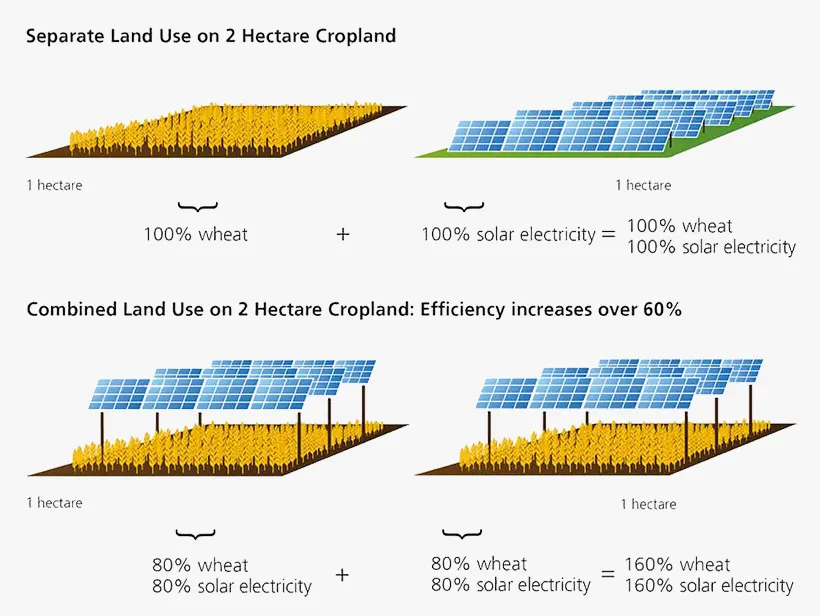
For example, you might dedicate a hectare of land entirely to wheat production or install solar panels for renewable energy generation. Agrivoltaic systems, however, can boost this hectare's production efficiency by 60%.
This increase occurs because cultivating wheat within a solar array can yield 80% of the land's maximum wheat capacity while simultaneously generating 80% of its total renewable energy potential. By combining these outputs, you achieve a 160% utilization rate compared to dedicating the land exclusively to wheat or solar energy.
How Does It Benefit Farmers?
Most people would think that having solar panels on farmland is a bad thing. Farmers benefit from agrivoltaics technology because they can farm and generate money from solar production in the same space.
Types of Agrivoltaic Systems
According to the most recent research, there are three design variants with detailed techno-commercial viability on the market. Furthermore, each agrivoltaics system has benefits and drawbacks.
1. Regular Reinforced Mount
The reinforced regular-mount system is similar to the ground-mount system in design, with minor vertical and horizontal spacing changes.
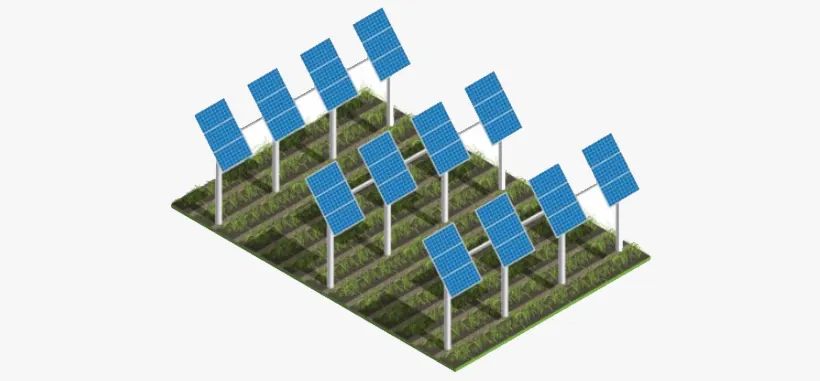
2. Vertical Mount
Solar modules are installed perpendicular to the ground in the vertical mount agrivoltaic design. As a result, the ground coverage ratio (GCR) is insignificant. There are no inter-module spacing requirements. In this design, inter-row spacing is also at its lowest.
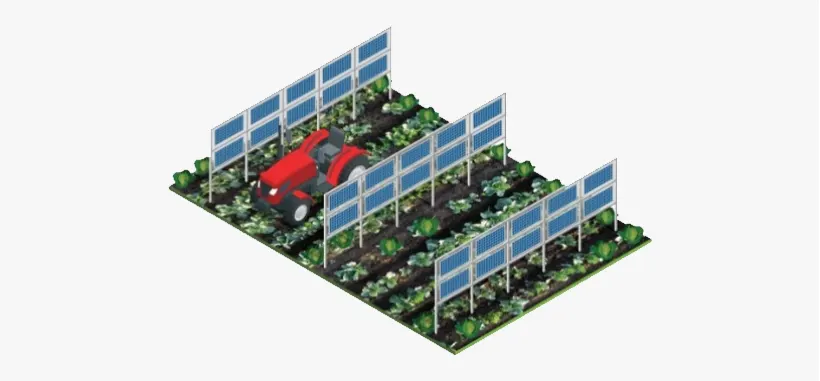
3. Tracker Stilt Mount
For maximum solar energy harvesting, this design incorporates a solar tracker into the PV modules. The spacing requirements are identical to those of a reinforced regular mount system.
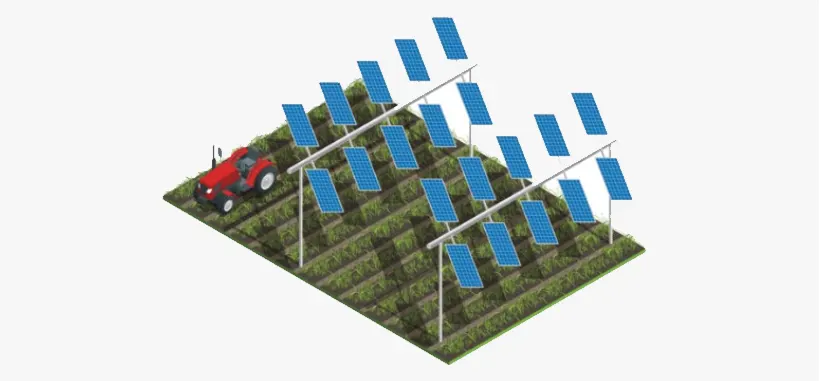
Agrivoltaics Advantages
Agriculture and solar PV generation both require a lot of space, but they don't have to compete. In fact, there are numerous ways in which farming and solar panels complement each other.
1. Crop-Related Benefits
Some of the most significant benefits of agrivoltaics have been observed in hot and arid regions, where PVs provide shade and aid in groundwater retention. In Arizona, for example, one study discovered that using solar panels doubled the production of cherry tomatoes and tripled the production of chiltepin peppers. Similar results were observed on a test plot in Kenya, which required 47% less water for irrigation and produced cabbages that were 24% larger.
It is important to note that not all crops thrive in partial shade. Wheat, for example, is incompatible with agrivoltaics because it requires a lot of sunlight. If the soil beneath the PV panels is unsuitable for plant growth, sheep or other small livestock can graze the pasture below while sheltering from the elements, allowing for dual use.
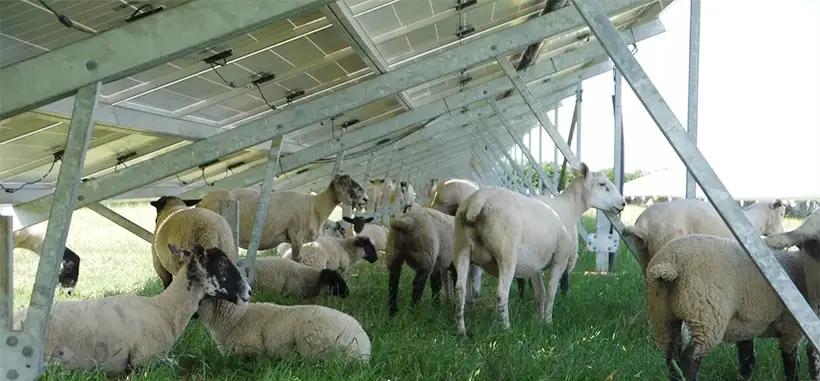
2. Income Diversification for Farmers
Combining PV generation with other agricultural outputs, such as crops or livestock, provides farmers and ranchers with multiple income streams that provide more stability than either source of income alone. Landowners begin earning passive income once the equipment is installed and solar energy is generated.
3. Improved Working Conditions for Farm Workers
A farmer's health can be jeopardized when farming in hot, sunny weather. Heatstroke and skin cancer are real concerns for people who work long hours in hot, sunny weather. Fortunately, farmers can work under a lot of shade provided by solar panels, giving them much-needed protection from the sweltering sun.
4. Conservation of Water
Water is a major issue when solar energy generation and agriculture operate independently. When agriculture and solar panels coexist in the same space, the problem of freshwater evaporation is solved. The panels' moderate shade helps to prevent water evaporation from the soil and reduces transpiration in the plants, which is beneficial if you live in a drought-prone area.
Solar panels, which are typically installed seven to ten feet above ground in agri-solar setups, provide shade during the hottest part of the day. Shade-loving and heat-sensitive crops benefit from the indirect sunlight and resulting cooler temperatures.
Because water consumption in agriculture can be very high (depending on the crop), Agri-PV systems provide significant added value in areas with low water availability or high levels of sunlight by assisting in water conservation.
5. Crop Protection
Extreme weather events such as hail, storms, drought, heavy rainfall, and heat waves are becoming more common. Our Agri-PV systems' rows of solar panels provide the best possible protection for your crops. This is particularly beneficial for crops that cannot tolerate direct sunlight.
Agrivoltaics Disadvantages
Agrivoltaic technology is increasingly becoming a part of farming culture, but there are some drawbacks to this technology that you should be aware of before investing in it.
1. Regulatory and Collaborative
State and county regulations governing solar development vary, often posing challenges for both solar developers and farmers, sometimes necessitating environmental impact assessments. Collaborating among farmers, local communities, and energy companies generally entails a lengthy and complex process.
2. Cost
The primary disadvantage of agrivoltaic systems is the high cost of installation and infrastructure. Farmers must be able to afford the costs of mechanical structures in particular. When compared to conventional roof mounted PV, dual use solar systems necessitate larger, more complex mounting systems that can cost up to triple the cost of a flat roof PV system installation.
Agrivoltaics also necessitates technical expertise, which most farmers lack. It is possible that they will struggle to repair anything that breaks, necessitating the hiring of professionals. As a result, many individuals may find the cost of professional labor prohibitively expensive.
3. Agricultural Equipment
Utilizing agricultural equipment becomes problematic when PV panels and racking systems occupy the land. Raising these panels or increasing the spacing between rows might simplify farming operations, though these solutions are not without their downsides. Such changes could lead to higher costs or the need for more land.
4. Water Availability
Securing water for livestock and irrigation is challenging in certain locations, especially where agriculture is a primary activity. Arid areas in the Western U.S. are often poorly suited for agricultural endeavors, limiting the feasibility of dual-use solar projects. Furthermore, since solar installations may cast shade over the fields, selecting appropriate crops is very important—some thrive under shade, while others do not.
5. Land Impact
Machinery used during the installation of solar arrays can compact the soil, and sometimes, the removal of topsoil can degrade the land's fertility. Additionally, solar developers face liability risks if they grant extensive access to their solar farms, especially to those operating farm machinery. Damage to solar components like photovoltaic panels, racking systems, conduits, or inverters not only disrupts power generation but also drives up repair costs.
Our Agricultural PV Mounting Systems
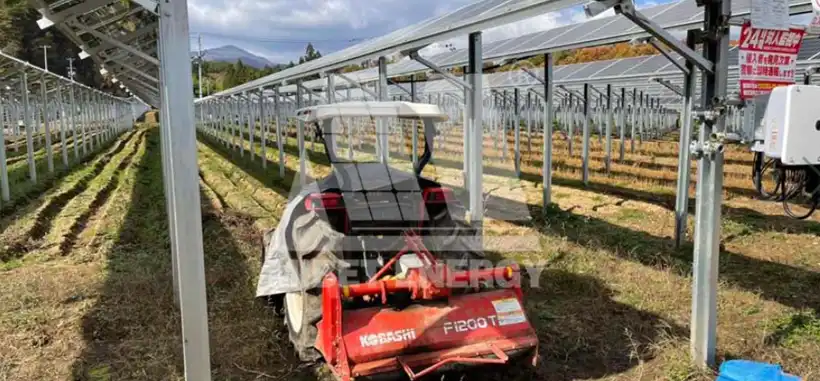
Using Agri-PV, your land maintains its original agricultural function while also producing clean electricity. However, because farming is so complex, you'll need an Agri-PV solution tailored to your specific location.
Crops grow between large-spaced, ground-level rows of module rows in an agricultural farmland solar mounting system, allowing room for machinery to pass through. Crops are grown beneath elevated solar modules with Overhead PV.
Our fixed tilt mounting system design comes with the best angle for your country's latitude and works best if your field is planted east-west. When the agricultural field is particularly uneven or on a slope, it is preferred over a tracker system.
Final Thoughts
Everything in the world has advantages and disadvantages, and agrivoltaics is no exception.
Despite this, agrivoltaics is gaining popularity. Farmers and researchers have discovered that solar energy production and agriculture and animal husbandry work well together. Microclimates generated by agrivoltaic infrastructure are beneficial to both crops and livestock, with the former actually enhancing the efficiency of the latter.
Countries such as China, Italy, Japan, Germany, and the southern part of Africa have begun to implement the Agrivoltaic system, particularly in areas where land is scarce, such as Japan. There are over 1,000 Agrivoltaic solar systems in Japan, and more contracts have been initiated to develop additional Agrivoltaic sites.
Mibet can design a suitable Agri-PV system for various crops based on the needs of the client and contribute to agriculture's future.

